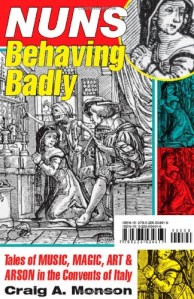Review: Nuns Behaving Badly January 8, 2011
Author: Beach Combing | in : Modern , trackback
Crag Monson, Nuns Behaving Badly: Tales of Music, Magic, Art and Arson in the Convents of Italy (University of Chicago 2010)
Mrs B. bade farewell, a decade ago, to a Catholic friend who had decided to pass into a nunnery in the Swiss Alps. Giulia, then in her twenties, said goodbye to family and friends for the last time and married Christ up near the Matterhorn. If she is still alive she wakes up every day at 3.30 AM and spends about six hours in the church in prayer and six hours in her room in meditation day after day, month after month, year after claustrophobic year…
Mrs B. consoles herself that Giulia made her own choice to go ‘to fields where flies no sharp and sided hail/ and a few lilies blow’. But, of course, through much of Christian history nuns and monks went into the desertum not because they wanted to but because their family thought that it would be an excellent idea to have a representative behind the grill. The result? Many young men and women were signed up for a vocation that had been designed to strain those whose will was strongest. In the eye of the Church such lukewarm individuals would be ‘perfected’. Whereas, of course, what actually happened was that religious communities were degraded and began to resemble the inside of the Big Brother House.
Enter our author.
Professor Craig Monson had the happy idea of making merry with five of these irruptions of the world into monastic life in seventeenth- and eighteenth-century Italy.
The material he has dug up, in part, in the Vatican’s archives, is so good that it could write itself: arsonist nuns, a nun going out to the opera disguised as an abbot, nuns summoning the devil and, Beachcombing’s favourite, nuns volunteering as snowball targets for monks…
If that were all then Beachcombing would still give notice of this book. But reflect. The work on Beachcombing’s table is not called The Limits of the Cloister in Early Modern Italy but Nuns Behaving Badly. The author is pictured on the flap not in a cathedra with book shelves over his bald patch, but with a cowboy hat and very dark shades. Then, instead, of a tasteful etching of a monastery on the back cover there is a bare-bottomed nun being spanked by a lascivious monk…
What Beachcombing is trying to say, as delicately as possible, is that this is one of these cases where subject matter and author are equal to each other.
Nor has CM made the mistake of turning his five ‘case studies’ into micro-histories to be examined, dissected and ultimately destroyed. Instead, we have five ‘events’ told with the cadence of stories that are spun out minus those irritating twenty-first-century cue-boards telling the reader when to laugh or cry. Beachcombing was, in fact, so impressed by the delicacy of the writing that he sometimes found himself wondering: ‘How did he get this past his crowd-pleasing editor…’
But there is more, something that Beachcombing only glimpses but that he wants to try and set down, even if, inadequately.
History is a garment sewn together from many parts. For most of the time the sewing is out of view. But, sometimes while reading about the past we glimpse, Beachcombing will call them, the seams of history. Beachcombing has this sense when he reads early medieval autobiography (in as much as there is any), Victorian erotica, post war declamations… These are all genres that are strangely unsuited to their periods and cause their authors, in the effort of writing, to peel away the pretences and illusions of their time. Beachcombing theorises that works in which Christianity is lived badly are the Early Modern equivalent of, say, Walter: A Secret Life. And on reading these episodes from the Italy of three or four hundred years ago, there is that rare moment when Beachcombing sits up and says: so that was what it was really like…
Beachcombing has only one complaint: not enough lesbianism. Does this reflect badly on the archives, the author, early modern Italy or Beachcombing himself? The resounding reply is duly noted.
Beachcombing is always on the look out for good books with demented subject matter: drbeachcombing AT yahoo DOT com
***
27 Feb 2011: Judith Weingarten writes in with further reading tips: Guido Ruggiero, /The Boundaries of Eros: Sex Crime and Sexuality in Renaissance Venice /(New York, 1985), particularly his history of the convents of the time, you should certainly read it. Also on the erotic nunnery reading list should be Pietro Aretino, /The Secret Lives of Nuns/ (trans. Rosa Maria Falvo, Hesperus Press, 2003) — albeit more dubbióso. Thanks Judith!



